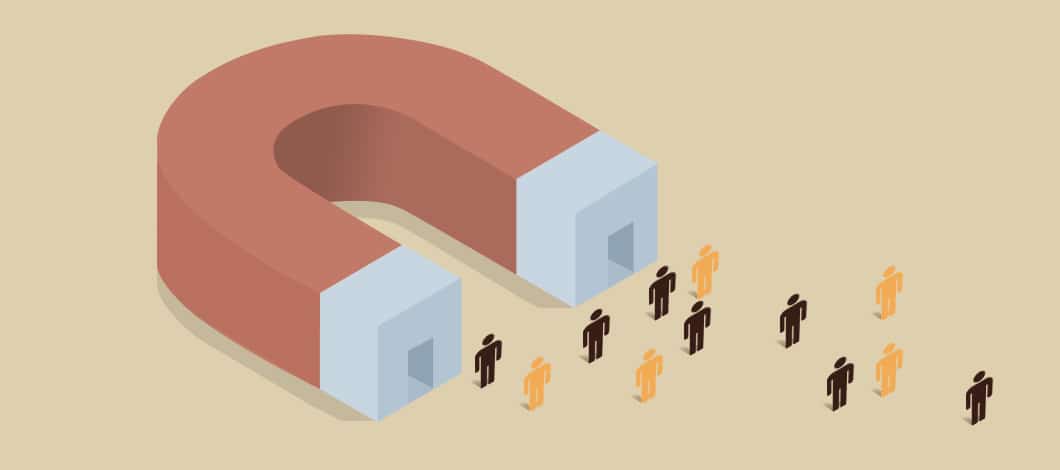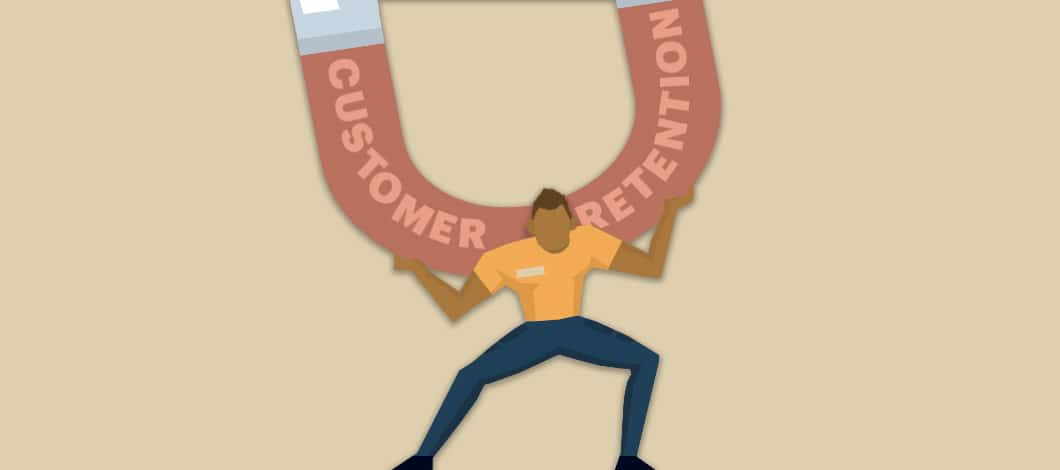Customer retention rate has a direct impact on your revenue.
Here’s a look at what it is, how to measure it and how to improve it.
What Is Customer Retention Rate?
Customer retention rate is a metric that tells you how many of your customers remain paying ones over a given time period. It is measured by comparing the number of customers you have at the end of the period with the number you had at the beginning after new customers have been factored out.
Customer retention rate is closely related to another common metric, customer churn rate. Whereas retention rate measures how many customers you keep over a certain period, churn rate measures how many customers you lose. In this way, churn rate represents the opposite of retention rate. The higher your retention rate, the lower your churn rate and vice versa.
Customer retention rate is emphasized in industries that rely heavily on repeat business. For instance, companies that sell software apps where buyers renew their subscriptions periodically pay close attention to customer retention data. Although retention rate is especially emphasized in the tech industry, it is important in any industry where revenue depends on steady repeat business.
Why Is Measuring Customer Retention Important?
Tracking customer retention metrics can help you in a number of ways:
- Acquiring new customers can be expensive. For example, costs for acquiring new customers through organic search engine marketing can range from $87 per customer in the retail industry to $862 for educational institutions, according to data collected by search engine optimization provider First Page Sage. For inorganic marketing, costs can run as high as $1,985 per customer. Placing an emphasis on retaining customers allows you to spend less on acquisition to maintain your revenue levels.
- When you actively track your customer retention rate, you can measure exactly how well you’re doing at keeping customers. This provides you with baseline numbers you can use to set goals for improvement.
- Tracking your customer retention rate further enables you to measure the effectiveness of actions you take to improve retention. You can see which retention strategies are working and which aren’t. This lets you know where to invest your resources for maximum results.

How Do You Calculate Retention Rate?
To calculate customer retention rate, use a ratio expressed as a percentage to compare the number of customers you kept over the period being measured (typically a month) with the number you had when the period started. New customers gained over the period are factored out so you can focus on how well you did at keeping the customers you originally had.
A standard retention rate formula is:
CRR = [(E – N) / S] x 100
In this formula:
- CRR stands for customer retention rate
- E stands for customers at the end of the period being measured
- N stands for new customers acquired during the period
- S stands for how many customers you had at the beginning of the period
Multiplying by 100 converts the resulting ratio to a percentage. If the quantity of (E – N) is equal to S, you will have 100% retention. If the quantity is less than S, you will have retention below 100%. You can’t get a result above 100%. The lower E is, the lower your retention rate will be.
A Customer Retention Rate Example
To illustrate how to apply this formula, let’s assume that at the beginning of the month, you had 1,000 customers. During the month, you lost 800 customers but you gained 400 for a net loss of 400, giving you 600 customers at the end of the month.
The numbers you would insert into the formula would be:
E = 600
N = 400
S = 1,000
CRR = [(600 – 400) / 1,000] * 100 = (200/1000) x 100 = 20
So, in this case, your retention rate would be 20%.
What Is a Good Customer Retention Rate?
A breakdown of the average customer retention rate by industry shows significant variation.
A cross-industry comparison by analytics provider Mixpanel found that in most industries, the average customer retention rate over an 8-week period falls below 20%. In the media and finance industries, a retention rate of more than 25% ranks as elite, while in the software as a service and ecommerce industries, top performers have retention rates exceeding 35%.
The ecommerce industry illustrates how retention rates can vary within industries. A survey of ecommerce companies by website conversion optimization provider Omnichannel found retention rates tended to range between 16% and 70%, with more than a third of companies reporting rates between 16% and 50%:
- 12% of companies reported retention rates up to 15%
- 21% had retention rates of 16% to 30%
- 16% had retention rates of 31% to 50%
- 12% had retention rates of 51% to 70%
- 9% had retention rates exceeding 70%
- 31% didn’t know
You can use these numbers as a rough guideline to gauge your own performance. However, it’s more important to improve your own numbers than to focus on how other companies are doing. Start with your own current retention rate and build from there.

How Can You Increase Customer Retention Rate?
To improve customer retention, you can use a number of strategies, including:
- Set retention goals
- Create a path for repeat business
- Improve the customer experience
- Deliver good customer service
- Remind customers when it’s time to renew
- Extend offers at strategic moments
- Reward customer loyalty
- Track retention results
Here are some tips on putting these methods into effect.
1. Set Retention Goals
A starting point is setting goals. Use your current retention rate as a starting point. Compare that with average numbers in your industry to give you a range to shoot for.
Consider what type of retention rate you would need to reach your revenue targets or achieve other goals such as lowering customer acquisition costs.
2. Create a Path for Repeat Business
You can approach guiding your customers toward retention more efficiently by planning which steps they should take after their initial purchase to become repeat buyers. You can do this by creating a customer lifecycle map, which is a step-by-step outline charting what optimal outcomes your customers should experience at each stage of their journey with you to progress toward the next stage of becoming a repeat buyer.
For example, if your company uses a subscription software model, you can identify what needs to happen to dispose your customer toward renewing their subscription. This might include completing their profile set-up, reaching a certain level of monthly log-in activity, resolving any support issues and receiving a renewal reminder.
3. Improve Customer Experience
A satisfying customer experience makes customers more likely to buy from you again. You can improve retention by taking steps to improve customer experience, such as:
- Improving your product based on customer feedback
- Optimizing your website design to make it easier to navigate
- Improving customer shopping experience by making it easier to use your online shopping cart
Track customer satisfaction to verify that your efforts to improve customer experience are working.
4. Deliver Good Customer Service
The quality of your customer service can play a crucial role in customer decisions about remaining with a brand. Track your most frequent customer support requests and update your products and procedures to avoid common problems. Monitor average response time and look for ways to accelerate the speed of your support.
Consider whether adopting automation tools such as chatbots might improve your support.
5. Remind Customers When It’s Time to Renew
One reason some customers may leave is that they forgot it was time to renew their subscription or service. Jog their memory by sending reminders as renewal time approaches.
You can automate the process of sending reminders by using technology tools such as autoresponder email sequences.
6. Extend Offers at Strategic Moments
In addition to sending renewal reminders, you can promote repeat business by extending offers at other strategic moments in your customer’s journey. For example, if you’ve recently upgraded a product a customer previously purchased, you might let them know the new version is available.
Another method you can use is tracking how customers are using their purchase and offering a product or service which expands the functionality and increases the value of what they already bought.
7. Reward Customer Loyalty
Giving customers an incentive to buy from you again can increase their likelihood of becoming repeat customers. A simple way to do this is by offering a customer loyalty discount for repeat buyers.
Other ways to reward customer loyalty include free bonuses, exclusive early-bird sales offers and discounts or bonuses for referrals.
8. Track Retention Results
As you implement the retention strategies above, tracking your results will let you know what’s working and what isn’t.
You can then make adjustments and improvements by scaling up what’s working and modifying what isn’t. For best results, use an automated dashboard and reporting system and schedule regular reviews of your retention rate.
Manage Your Customer Retention Rate to Increase Your Profits
Customer retention rate tells you how many of your customers stick around as repeat buyers of your product or service. Knowing this helps you evaluate how successful you are at instilling customer loyalty, putting you in a position to make adjustments and improvements.
You can calculate retention rate by using a formula that compares how many customers you kept over the course of the month to the number you had at the start of the month.
What constitutes a good retention rate varies by industry. To improve your retention rate, take steps such as setting retention goals, improving user experience, delivering superior service and extending upsell offers.
Use these strategies to retain more customers — and generate more sales.










